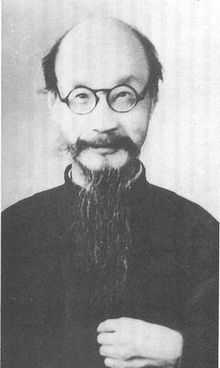Liu Yizheng

Liu Yizheng (柳詒徵) (1880–1956) was a Chinese modern historian, calligrapher, librarian, cultural scholar, educator and academic leader.
Early life under the Qing dynasty
Born and educated under the Qing dynasty (1644–1912), Liu passed the first level of the imperial civil service examination a few years before its abolition in 1905.[1] In the early 1900s his mentor the philologist Miao Quansun (繆荃蓀; 1844–1919) put him in charge of writing a textbook on Chinese national history that had been commissioned by the reformist high official Zhang Zhidong (1837–1909).[1] Liu's Brief Account of the Past (Lidai shilue 歷代史略), an adaptation of Japanese historian Naka Michiyo's (那珂通世; 1851–1908) General History of China (Shina tsūshi 支那通史), was published in Nanjing by a government press in 1902.[2] After a two-month visit to Meiji Japan in 1902 during which he was impressed by the new Japanese education system, Liu used his new textbook to teach history in schools that had been created as part of the late Qing "New Policies" (Xinzheng 新政, 1901–1911).[1] In 1905 the new Ministry of Education (Xuebu 學部) officially designated Liu's Brief Account as a national textbook.[1]
Republican times
After the Qing fell and was replaced by a Republican government, Liu opposed Hu Shi's call for a "literary revolution" that consisted in replacing classical Chinese with more vernacular forms of writing, a kind of reform advocated by the intellectuals of the New Culture Movement.[3] Refusing to ascribe China's recent difficulties to Confucianism or traditional Chinese culture, Liu attributed them to the Manchus, the Opium War, corrupt government, warlords, and all kinds of social problems which, he argued, had nothing to do with Confucianism.[4]
In the 1920s Liu wrote several historical articles for the Critical Review (Xueheng 學衡), a literary journal that was founded in 1922.[5] In some of these articles he defended the value of traditional historical scholarship, disagreeing with Gu Jiegang and other advocates of the Doubting Antiquity School, who doubted the reliability of ancient Chinese historical records.[5] Liu's History of Chinese Culture (Zhongguo wenhua shi 中國文化史), a cultural history of China from times immemorial to the 1920s, was first serialized in the Critical Review from 1925 to 1929 before being published as a book in 1932.[6] Though Liu's scholarship is usually viewed as conservative, his book laid the foundation for a discussion of China as a cultural entity rather than a racial one as was common at the time.[7]
Liu Yizheng wrote several books on Chinese history, including on the history of education, commerce, and culture. History of Chinese Culture (中國文化史) and Essentials of National History (國史要義) are his most important works.
Notes
- ↑ 1.0 1.1 1.2 1.3 Tze-ki Hon, "Educating the Citizens: Visions of China in Late Qing Historical Textbooks," in The Politics of Historical Production in Late Qing and Republican China, edited by Tze-ki Hon and Robert J. Culp (Leiden: Brill, 2007), p. 85.
- ↑ Hon, "Educating the Citizens," pp. 81 (translation of Lidai shilue; publication info), 84 (Nanjing), and 85 (Naka Michiyo's textbook).
- ↑ Q. Edward Wang, Inventing China Through History: The May Fourth Approach to Historiography (Albany, NY: SUNY Press, 2001), p 65.
- ↑ Lydia H. Liu, Translingual Practice: Literature, National Culture, and Translated Modernity, China, 1900–1937 (Stanford, Stanford University Press, 1995), p. 252.
- ↑ 5.0 5.1 Q. Edward Wang, "Toward a Humanist Interpretation of Tradition: The Hermeneutics of the 'Critical Review Group'," in Interpretation and Intellectual Change: Chinese Hermeneutics in Historical Perspective, edited by Ching-I Tu (New Brunswick, NJ: Transaction Publishers, 2005), p. 270.
- ↑ Tze-ki Hon, "National Essence, National Learning, and Culture: Historical Writings in Guocui xuebao, Xueheng, and Guoxue jikan," Historiography East & West 1.2 (2003): 262.
- ↑ Tze-ki Hon, "Cultural Identity and Local Self-Government: A Study of Liu Yizheng's History of Chinese Culture," Modern China 30.4 (October 2004): 508.